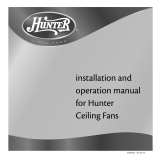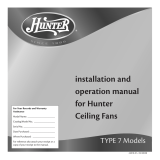Hunter Fan 20771 is a ceiling fan that can be installed with three different mounting options: standard, low profile, and angle mount. It requires a 9/64” drill bit, standard screwdriver, Phillips-head screwdriver, wrench or pliers, and a ladder. The included 3/4” diameter pipe ensures stability and wobble-free performance. Optional accessories include wall-mounted or remote speed control so that you can adjust the fan’s three speeds from afar. All wiring must comply with national and local electrical codes and standards.
Hunter Fan 20771 is a ceiling fan that can be installed with three different mounting options: standard, low profile, and angle mount. It requires a 9/64” drill bit, standard screwdriver, Phillips-head screwdriver, wrench or pliers, and a ladder. The included 3/4” diameter pipe ensures stability and wobble-free performance. Optional accessories include wall-mounted or remote speed control so that you can adjust the fan’s three speeds from afar. All wiring must comply with national and local electrical codes and standards.














-
 1
1
-
 2
2
-
 3
3
-
 4
4
-
 5
5
-
 6
6
-
 7
7
-
 8
8
-
 9
9
-
 10
10
-
 11
11
-
 12
12
-
 13
13
-
 14
14
Hunter Fan 20771 Owner's manual
- Category
- Household fans
- Type
- Owner's manual
Hunter Fan 20771 is a ceiling fan that can be installed with three different mounting options: standard, low profile, and angle mount. It requires a 9/64” drill bit, standard screwdriver, Phillips-head screwdriver, wrench or pliers, and a ladder. The included 3/4” diameter pipe ensures stability and wobble-free performance. Optional accessories include wall-mounted or remote speed control so that you can adjust the fan’s three speeds from afar. All wiring must comply with national and local electrical codes and standards.
Ask a question and I''ll find the answer in the document
Finding information in a document is now easier with AI
Related papers
-
 Hunter Fan 28415 Owner's manual
Hunter Fan 28415 Owner's manual
-
 Hunter Fan 28529 Owner's manual
Hunter Fan 28529 Owner's manual
-
 Hunter Fan 23784 User manual
Hunter Fan 23784 User manual
-
 Hunter Fan 28639 Owner's manual
Hunter Fan 28639 Owner's manual
-
 Hunter Fan 23735 Owner's manual
Hunter Fan 23735 Owner's manual
-
 Hunter Fan 20740 Owner's manual
Hunter Fan 20740 Owner's manual
-
Hunter Fan 42008-01 User manual
-
 Hunter Fan 42679-01 User manual
Hunter Fan 42679-01 User manual
-
 Hunter Fan 42658-01 User manual
Hunter Fan 42658-01 User manual
-
 Hunter Fan 20432 Owner's manual
Hunter Fan 20432 Owner's manual
Other documents
-
Lightolier IS:T600 User manual
-
Riverstone K-SC512-30 User manual
-
Design House 578575 Operating instructions
-
Maxim 85880WTWT Installation guide
-
Maxim 5884MROI Installation guide
-
VISUAL COMFORT S 7760 User manual
-
Hunter 22565 Installation guide
-
Hunter 26418 Installation guide
-
Hunter 53066 Installation guide
-
Visual Comfort Studio TOB 5063PN-WG Installation guide






















